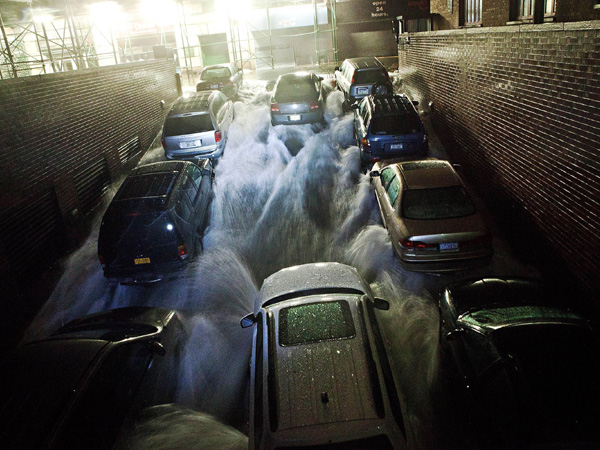
Rising water, caused by Hurricane Sandy, rushes into a subterranian parking garage on October 29, 2012, in the Financial District of New York, United States. AFP
NEW YORK — Hurricane Sandy turned New York into a disaster zone on Monday as a record storm surge sent seawater pouring into Manhattan, sweeping cars down streets as the city was plunged into darkness.
The Empire State Building remained an eerie beacon of light as 250,000 Manhattan homes were deprived of power, while emergency officials confirmed at least one 30-year-old man had died, killed by a falling tree in Queens.
The East River and the Hudson River flooded subway and car tunnels and several feet of seawater swamped into Battery Park at the foot of Lower Manhattan, with waters rising and the rain showing no sign of abating.
“Lower Manhattan is being covered by seawater. I am not exaggerating. Sea water is rushing into the Battery Tunnel,” said Howard Glaser, director of operations for the New York state government.
The Battery Tunnel is a road tunnel linking the south end of Manhattan, New York’s financial center, to Long Island under the East River.
Local energy supplier Con Edison reported that 250,000 customers had lost power in Manhattan alone.
In addition to the surging waters of the East and Hudson rivers, the city was by battered by what the National Weather Service called “hurricane-force gusts” of more than 90 miles per hour (145 kilometers per hour).
As the evening tide hit its height the storm surge was a record 13.7 feet (4.2 meters). Before Hurricane Sandy made landfall, forecasters had warned than any more than 11 feet could cause catastrophic flooding.
Cars could be seen afloat in several Manhattan streets, and the facade of a six-story building collapsed.
Local broadcaster WNBC said some houses on Staten Island were “flooded up to their attics,” while the New York police department sought boats to conduct rescue missions there and on Brooklyn’s Coney Island.
Floods swamped cars in Brooklyn, while fierce gusts pushed over a crane on a Manhattan skyscraper — leaving it dangling perilously atop the 90-story luxury apartment.
The boom of the crane swayed in the fierce gusts over streets near Central Park that police and fire services evacuated because of the risk that it could fall.
Gas and water pipes at street level were closed and city engineers and fire department experts climbed the 1,004-foot (306-meter) building to assess the danger.
In another spectacular demonstration of its power, the hurricane pulled off the facade of a three-story building in the Chelsea district. Again no injuries were reported.
Tens of thousands of people ignored appeals by New York Mayor Michael Bloomberg to leave the districts at risk.
“If water is coming into your home, go to the highest area,” Bloomberg advised citizens as he held a hastily-arranged press conference amid the worst of the carnage.
“It’s still very dangerous and from now until the storm is well passed you just have to shelter in place. You need to stay wherever you are. Let me repeat that. You have to stay wherever you are.”
New York authorities had earlier closed the subway train system and nearly all tunnels and bridges that take traffic off Manhattan as the full force of Sandy hit America’s biggest city.
With Wall Street closed for the first time since the September 11, 2001 attacks and the city at a near standstill, police went to several districts with loud speakers and special buses trying to persuade people to move.
New York state also called up more than 2,100 National Guard troops on Sunday and Monday to patrol threatened districts.
Authorities issued a mandatory evacuation order for 375,000 people at risk from a storm surge predicted to be over 11 feet (3.5 meters), but the majority decided to brave it out.
As night fell, Bloomberg had warned that it may be too late to get away.